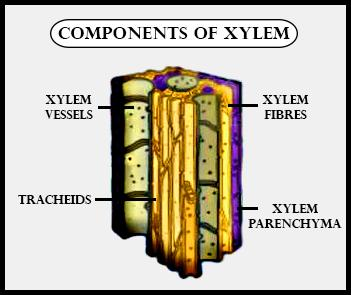
Which is the living component of xylem?
A. Tracheids
B. Xylem fibers
C. Xylem parenchyma
D. Trachea
Answer
506.4k+ views
Hint: A permanent tissue present in the vascular tissues of a plant whose main function is to transport water and is known as the conducting tissue of the plant body and fulfilling the requirements of nutrients of them.
Complete answer:
The living component of xylem is the xylem parenchyma. They help in the conduction of water in the upward direction and are present in the lining of the conducting elements.
Additional Information:
-The plant has vascular tissues that are also known as the conducting tissues.
-The vascular system is of two types: xylem and phloem.
-Xylem helps in the conduction of the water while phloem helps in the conduction of the food.
-Xylem consists of various types of cells depending upon their structure and function: tracheids, vessels, xylem parenchyma, and xylem fibers.
-Xylem tissues are found in the non woody plants.
-The xylem is of two types during the secondary growth of the plant: Primary xylem and secondary xylem.
-During the primary growth, the primary xylem is formed which gives rise to metaxylem and protoxylem.
-During the secondary growth, the secondary xylem is developed from the vascular cambium.
-The tracheids and vessels of the stem, roots, and leaves are interconnected helping in the conduction of the water throughout.
-The water is transported from roots to the stem and from the stem to the leaves. The water is absorbed by the root hairs of the roots.

So, the correct answer is ‘Xylem parenchyma'.
Note: The term Xylem was derived from the Greek word xylon which means the wood. It was first introduced in 1858 by Carl Nageli. Stephen Hales, the clergyman, and botanist of England showed in 1727 that during the process of transpiration the water which is released from the leaves is carried outside with the help of the xylem. Edward Strasburger, the Polish-German botanist for the first time showed in 1891 that the xylem tissues needed for the conduction of water should not always be alive.
Complete answer:
The living component of xylem is the xylem parenchyma. They help in the conduction of water in the upward direction and are present in the lining of the conducting elements.
Additional Information:
-The plant has vascular tissues that are also known as the conducting tissues.
-The vascular system is of two types: xylem and phloem.
-Xylem helps in the conduction of the water while phloem helps in the conduction of the food.
-Xylem consists of various types of cells depending upon their structure and function: tracheids, vessels, xylem parenchyma, and xylem fibers.
-Xylem tissues are found in the non woody plants.
-The xylem is of two types during the secondary growth of the plant: Primary xylem and secondary xylem.
-During the primary growth, the primary xylem is formed which gives rise to metaxylem and protoxylem.
-During the secondary growth, the secondary xylem is developed from the vascular cambium.
-The tracheids and vessels of the stem, roots, and leaves are interconnected helping in the conduction of the water throughout.
-The water is transported from roots to the stem and from the stem to the leaves. The water is absorbed by the root hairs of the roots.

So, the correct answer is ‘Xylem parenchyma'.
Note: The term Xylem was derived from the Greek word xylon which means the wood. It was first introduced in 1858 by Carl Nageli. Stephen Hales, the clergyman, and botanist of England showed in 1727 that during the process of transpiration the water which is released from the leaves is carried outside with the help of the xylem. Edward Strasburger, the Polish-German botanist for the first time showed in 1891 that the xylem tissues needed for the conduction of water should not always be alive.
Recently Updated Pages
Master Class 11 Economics: Engaging Questions & Answers for Success

Master Class 11 Business Studies: Engaging Questions & Answers for Success

Master Class 11 Accountancy: Engaging Questions & Answers for Success

Master Class 11 English: Engaging Questions & Answers for Success

Master Class 11 Computer Science: Engaging Questions & Answers for Success

Master Class 11 Maths: Engaging Questions & Answers for Success

Trending doubts
Which one is a true fish A Jellyfish B Starfish C Dogfish class 11 biology CBSE

State and prove Bernoullis theorem class 11 physics CBSE

1 ton equals to A 100 kg B 1000 kg C 10 kg D 10000 class 11 physics CBSE

In which part of the body the blood is purified oxygenation class 11 biology CBSE

One Metric ton is equal to kg A 10000 B 1000 C 100 class 11 physics CBSE

Difference Between Prokaryotic Cells and Eukaryotic Cells




